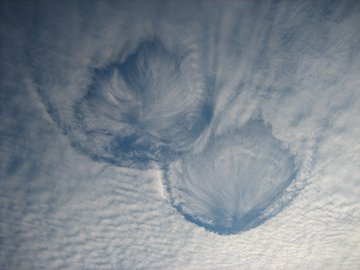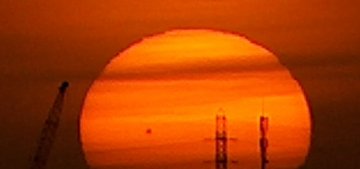 Autumn is here, and it's a wonderful time for stargazing. Find out what's up from Spaceweather PHONE.
Autumn is here, and it's a wonderful time for stargazing. Find out what's up from Spaceweather PHONE.
RETURN OF THE LEONIDS: Earth is heading for a cloud of comet dust that could produce an outburst of Leonid meteors on Nov. 19th. Get the full story from Science@NASA.
HOLE PUNCH CLOUDS: The sky is full of mysteries, and one of them appeared over Wisconsin yesterday. "I live in Stevens Point on the University of Wisconsin campus, and I saw some very strange clouds," reports Samantha Weise who took this picture:

More images: #1, #2, #3, #4, #5, #6, #7
These are "hole punch clouds," and no one is certain what they are. One theory holds that hole punch clouds are formed by jet airplanes punching through a cirrocumulous cloud deck. When the jet pierces the cloud, supercooled water droplets in the cloud suddenly crystallize. This water-to-ice transformation proceeds outward from the point of impact, creating a vast circle of icy wisps--the "hole." But how many jets would it take to create this display?
Consider it a beautiful mystery!
SUNSPOT SUNSET: Sunspot 923 is so big, people are starting to notice it at sunset, when the sun is low and dimmed by clouds and pollution:

"While looking at pictures I took this evening, I was quite surprised to see the sunspot so clearly," says photographer Francesco De Comité of Mouscron, Belgium. "Digital cameras can make you feel like you are Galileo!"
more images: from Chuck Baker of Carlsbad, CA; from Mila Zinkova of San Francisco, CA; from Martin Mc Kenna of Maghera, N. Ireland; from Vasilis Wooseas of Greece.
WARNING: Even at sunset, you can damage your eyes by staring at the sun. Be careful. If you use a telescope, make sure it is safely-filtered. If you point a digital camera at the sun, look at the image on the LCD screen--not through the camera's viewfinder.

